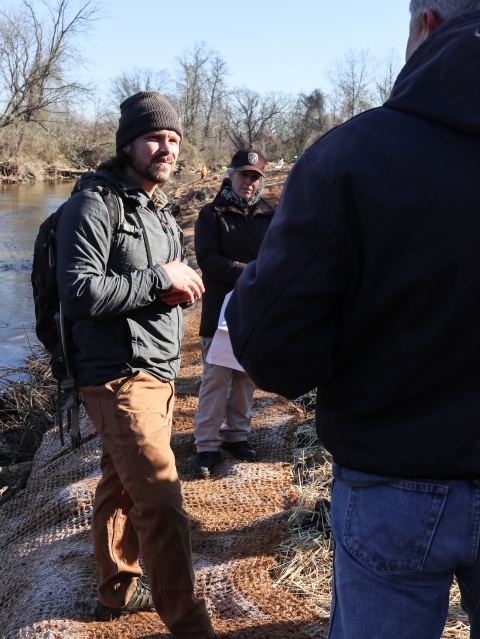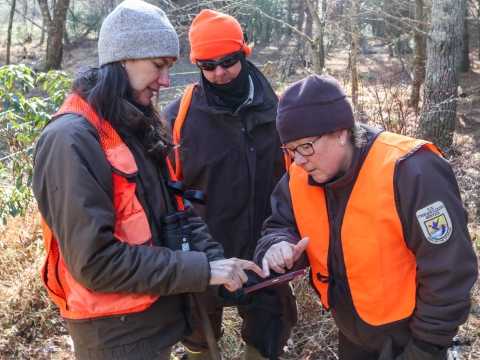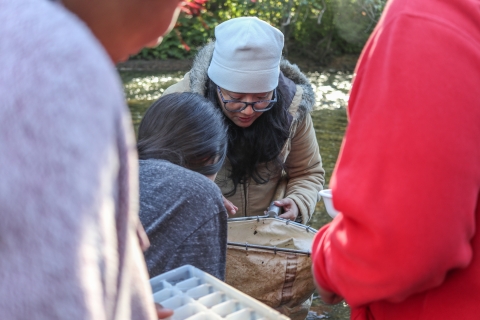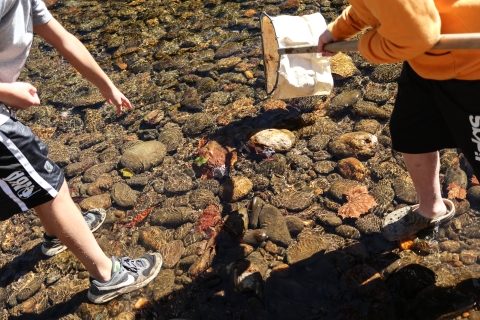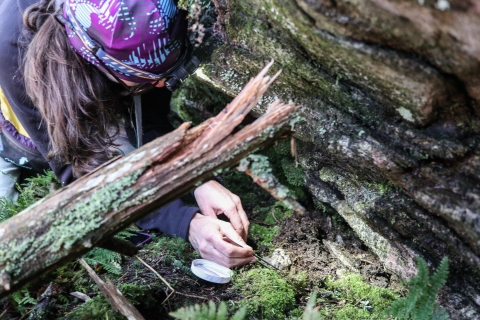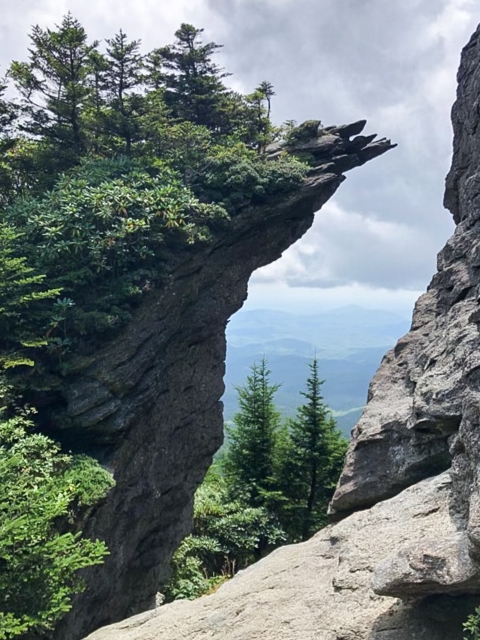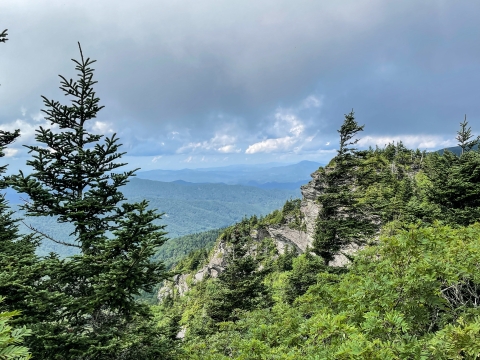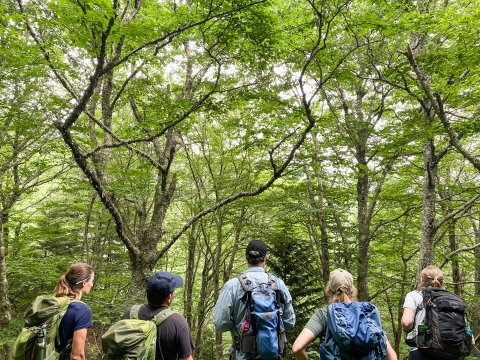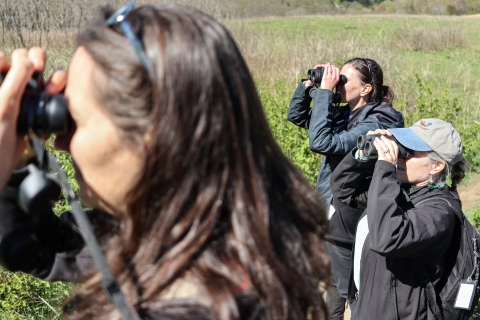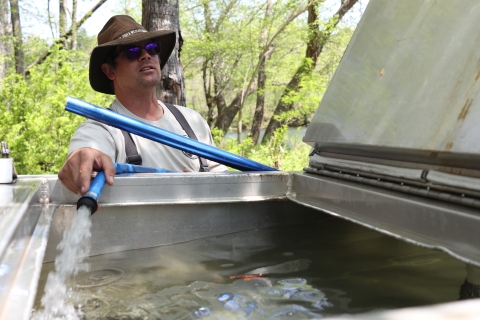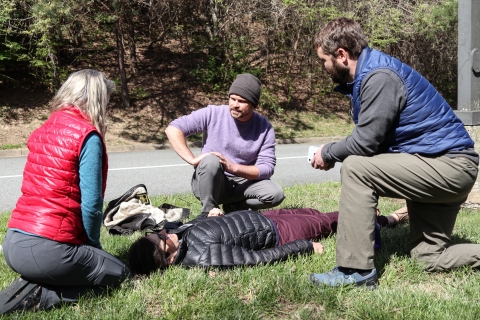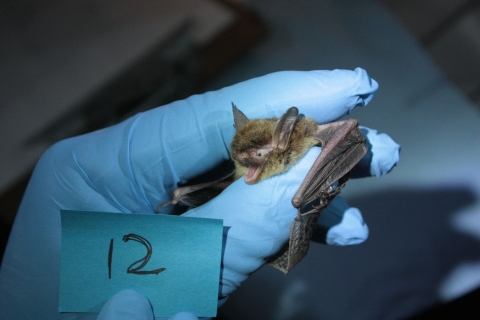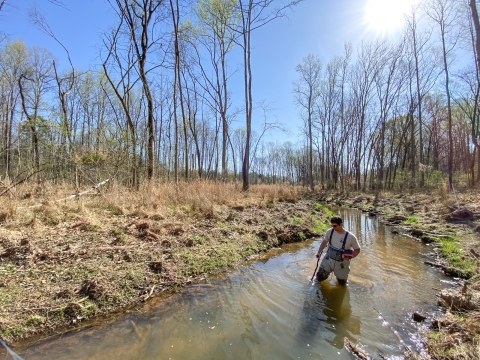2022 12 16 – Weekly staff notes
Discovering key information about imperiled mussels – Freshwater mussels, one of North America’s most imperiled animal groups, go through a brief phase early in their life when they attach themselves to a fish which provides the young mussel with nutrients and disperses the largely sedentary animals. Often each species of mussel relies on certain species of fish for this life stage. Asheville Field Office intern Rebekah Ewing successfully defended her master’s thesis at Appalachian State University, wrapping up research in which she confirmed one fish host and identified five new fish hosts for the endangered Appalachian elktoe; and identified five fish hosts for the longsolid, a mussel proposed for the federal threatened and endangered species list.
Mills River Stream Restoration – The Asheville Field Office administrative team of Karla and Jeff Quast visited a stream restoration project on western North Carolina’s Mills River, assisting with the planting of “live stakes,” or cuttings from live trees that will take root and grow into new trees upon planting. The Mills River is home to the endangered Appalachian elktoe mussel, and the restoration project is supported by the Service’s Partners for Fish and Wildlife Program, providing technical and financial assistance to habitat management on private, municipal, and county lands.
Speaking at Warren Wilson College – Dr. Natali Ramirez-Bullon of the Asheville Field Office spoke to students in Warren Wilson College’s senior-level plant ecology class. Her talk, “Refined Approaches to Improving Efforts to Conserve Plant Biodiversity,” stemmed from her recently completed dissertation in which she looked at developing a framework to identify conservation priorities when resources developed to supporting conservation are limited.
Friday, December 9
Updating the electo-fishing course –Running electric current through water to temporarily stun fish for capture is a fundamental technique used by aquatic biologists, but if not done properly, it can be a dangerous one, so for Service staff, training is required. The Service’s top-level electrofishing certification course, Principles and Techniques of Electrofishing, is being improved to reflect changing technology and the needs of an evolving workforce. Asheville Field Office biologist Jason Mays joined the course’s lead instructor at the Service’s national training center to assist with the update. The updated course will be offered in the spring.
Friday, December 2
Mills River site visit – Staff from the Asheville Field Office visited a Partners for Fish and Wildlife habitat restoration project that recently broke ground along western North Carolina’s Mills River. The project will stabilize eroding streambank upstream of a drinking water intake for the City of Asheville and is the latest in a string of restoration projects along the Mills River, home to the endangered Appalachian elktoe mussel.
Learning how to make the most of geographic data – Mark Endries, GIS analyst with the Asheville Field Office, recently taught Introduction to GIS at the National Conservation Trained Center (NCTC). Endries has long served as a GIS instructor, also teaching Field Techniques for Invasive Plant Management and Modeling Species Distributions with Maxent and ArcGIS Pro at NCTC; and Field Data Collection Using ArcGIS, Modelling Species Distributions with Maxent and ArcGIS Pro, Introduction to Survey123, Introduction to ModelBuilder, Introduction to Collector, ERATools, and Introduction to ArcPad at southeast regional trainings.
North Carolina Bat Working Group meeting – Sue Cameron and Lauren Wilson of the Asheville Field Office attended the 2022 meeting of the North Carolina Bat Working Group, held at the North Carolina Museum of Natural Sciences, which provided an opportunity for biologists to share and discuss the past year’s developments in bat conservation. Cameron serves as an at-large board member for the group which was formed in 2007 to promote the conservation of bats and their habitats in North Carolina through education and collaborative study, including the dissemination of information on research and policies.
Friday, November 25
Bog visits – Staff from the Asheville Field Office joined Jake Tuttle and Carolyn Johnson, manager and deputy manager of Piedmont, Bond Swamp, and Mountain Bogs National Wildlife Refuges, for a tour of southern Appalachian Mountain bogs. Tuttle became refuge manager earlier this year and took advantage of the trip to visit seven western North Carolina bogs, both within the refuge and managed by partners. The visit also provided an opportunity to discuss a process for engaging partners on bog conservation strategy.
Friday, November 18
Helping fish move upstream – Asheville Field Office staff Jason Mays, Jeff Quast, and Byron Hamstead joined biologists with the N.C. Wildlife Resources Commission to move smallmouth redhorse, smallmouth buffalo, and black buffalo above three impeding dams into historical habitat in the French Broad River. The French Broad is home to an expanding population of endangered Appalachian elktoe mussels, which have an early life stage where they attach themselves to fish gills for nourishment, eventually dropping off and settling into a different part of the river. The three translocated species are potential hosts for the elktoe and because they make annual long distance spawning runs, biologists are hopeful they will help spread the mussels throughout the river.
French Broad River surprise– Lauren Wilson and Jason Mays of the Asheville Field Office received a surprise recently when snorkeling the French Broad River, just upstream of the North Carolina/Tennessee state line. Although looking for mussels in relation to an NCDOT project, Mays came across an approximately 15-inch lake sturgeon resting on the river bottom. Lake sturgeon are currently being considered for Endangered Species Act protection and individuals, including some raised at Edenton National Fish Hatchery, are stocked into the Tennessee and North Carolina portions of the river.
Mills River Town Board – Asheville biologist Bryan Tompkins recently met with the town council of Mills River, N.C., to discuss the installation of a 15-acre pollinator meadow at their community park. The meadow will be a key feature of the community park and will include a separate 3,000 square foot monarch waystation. Several historic occurrence records of the federally endangered rusty-patched bumble bee are near the park. Walking trails and outreach signage will be included in the design, offering passive recreation opportunities such as birding and experiencing this important habitat type that has been diminished on the southern Appalachian landscape.
Friday, November 11
Cheoah River Pebble Count – Western North Carolina’s Cheoah River was once piped overland to a powerhouse facility, leaving a nine-mile river reach watered only by dam leakage and tributaries entering below the dam. That changed under the current hydro-power license, with flow returning to the dewatered stretch, home to the endangered Appalachian elktoe mussel and threatened spotfin chub. The current license also requires the licensee to supplement gravel in the bypass reach every two years to enhance stream-bottom habitat in the sediment-starved reach below the dam. Asheville Field Office staff Bryan Tompkins and Jeff Quast recently joined U.S. Forest Service staff for annual monitoring of how that supplemental gravel is moving through the river and enhancing stream-bottom habitat.
Working with historically marginalized landowners -Asheville Field Office biologist Laura Fogo participated in the "Partnering with Historically Marginalized Landowners" workshop in Summerfield, SC, hosted by the SCJ General Services and the Center for Heirs' Property Preservation. The workshop is part of a Service effort to reach out to and support historically marginalized landowners and communities. Fogo’s work supports wildlife habitat restoration and stewardship on private lands, and through the workshop she connected with and helped provide technical assistance to four Carolina families.
Keeping animals off the highway - Laura Fogo, Sue Cameron, Holland Youngman, Byron Hampstead, and Natali Ramirez-Bullon recently joined staff from the N.C. Department of Transportation, the N.C. Wildlife Resources Commission, Tangled Bank Conservation and volunteers from The Nature Conservancy to install approximately 3,000 linear feet of fencing along a western North Carolina highway. The fencing will keep small animals off the road, directing them to a small tunnel that was designed to enable animal movement between wetlands on either side of the road.
Friday, November 4
Mecklenburg County Mussel Move – Asheville Field Office staff Jay Mays and Jeff Quast joined Mecklenburg County, N.C. staff at a county nature center on Stephens Creek to stock mussels and monitor previous stocking efforts along the creek, the recent focus of a stream restoration project. Stephens Creek is in the Goose Creek watershed, home to the endangered Carolina heelsplitter mussel, and biologists are stocking the stream with common mussels to see how well they do, hopefully paving the way for eventual stocking of Carolina heelsplitters.
Friday, October 28
Bog workday - Susan Cameron, Byron Hamstead, and Natali Ramirez-Bullon recently spent a day managing a southern Appalachian bog in Alleghany County, N.C. The team focused on removing non-native invasive plants including multiflora rose, barberry and oriental bittersweet. Non-native plants outcompete native plants resulting in decreased diversity and habitat quality. Non-native invasive plants are one of several long-standing challenges with southern Appalachian bogs, whose numbers and extent have dwindled over the decades, with a multitude of organizations stepping up to help manage bog sites.
Final project review numbers – The final fiscal year 2022 numbers are in and the Asheville Field Office reviewed 305 projects, ranging from bridge replacements to national forest management, that may affect threatened or endangered species. After working with project proponents to minimize impacts, only seven were likely to adversely affect listed species. Additionally, office staff provided technical assistance on 419 projects, answering questions and helping identify ways to avoid listed species impacts.
Identifying environmental contamination - Asheville Field Office biologist Mark Endries joined National Wildlife Refuge realty expert Alice Lawrence to conduct a contaminants survey at a potential addition to Mountain Bogs National Wildlife Refuge. The survey is a standard part of refuge land acquisition to identify any contaminants issues before the Service takes ownership of the land.
Learning about pollinator conservation – North Carolina visitors driving I-26 can now stop at the welcome center just south of the Tennessee state line and learn about pollinator conservation thanks to the work of Asheville Field Office biologist Bryan Tompkins and the N.C. Department of Commerce. The welcome center, a registered monarch waystation, is home to a pollinator meadow planted between the center and the interstate, while inside, visitors can pick up information on pollinator conservation and planting to support pollinators. Tompkins is currently working with the N.C. Department of Commerce to offer a similar experience at a welcome center in I-77.
Friday, October 21
Spruce restoration - The Southern Appalachian Spruce Restoration Initiative held its annual meeting, a hybrid event, at North Carolina’s Grandfather Mountain. Asheville field office’s Gary Peeples entered his second year of a two-year term as co-chair while Sue Cameron and Mark Endries remained on the steering committee, and Natali Ramirez-Bullon also attended. The partnership is focused on restoring red spruce, a key habitat component in the high-elevation forests of Southern Appalachia that are home to the endangered Carolina northern flying squirrel and spruce-fir moss spider.
Friday, October 14
Bats documented in roost structure structure
Something temporarily or permanently constructed, built, or placed; and constructed of natural or manufactured parts including, but not limited to, a building, shed, cabin, porch, bridge, walkway, stair steps, sign, landing, platform, dock, rack, fence, telecommunication device, antennae, fish cleaning table, satellite dish/mount, or well head.
Learn more about structure – When a new bridge was built over the French Broad River, in Asheville, N.C., Asheville Field Office biologists Sue Cameron and Byron Hamstead worked with the developer to have a specially-designed artificial bat roost panel attached to the underside of the bridge. Last week Hamstead and Holland Youngman, also of the Asheville Field Office, visited the roost for the first time since installation and found a big brown bat, confirming the panel’s use by bats. This bodes well for area bats, as Youngman worked with the N.C. Department of Transportation to install similar panels to existing bridges in the area in connection with a major interstate widening project.
Sicklefin redhorse conservation – This week, Ian Jameson of Warm Springs National Fish Hatchery counted more than 10,000 hatchery-raised sicklefin redhorses, loaded them into a hatchery truck, and drove them to western North Carolina where he met Jason Mays and Jeff Quast of the Asheville Field Office, and staff from the Eastern Band of Cherokee Indians and N.C. Wildlife Resources Commission who helped release the fish across five North Carolina rivers. In 2016 the Service decided not to place the sicklefin redhorse on the federal threatened and endangered species list, but it’s the subject of a candidate conservation agreement under which several organizations pledged to support sicklefin conservation.
Friday, October 7
Toe in the Toe, Mitchell County – Mitchell County, N.C. is home to the endangered Appalachian elktoe mussel, and each year fifth-grade students from across the county descend on the North Toe River in Spruce Pine to learn about the river in the Toes in the Toe Festival. Students rotate through several stations, including one on aquatic invertebrates hosted by the Service and this year staffed by Byron Hamstead, Gary Peeples, Jeff Quast, and Natali Ramirez-Bullon. Service staff taught the students how to collect aquatic invertebrates, how to identify them, and what the invertebrate community says about stream health.
Dwarf-flowered heartleaf conservation – Six acres of land, providing habitat protection for nearly 300 threatened dwarf-flowered heartleaf plants, will go into a conservation easement conservation easement
A conservation easement is a voluntary legal agreement between a landowner and a government agency or qualified conservation organization that restricts the type and amount of development that may take place on a property in the future. Conservation easements aim to protect habitat for birds, fish and other wildlife by limiting residential, industrial or commercial development. Contracts may prohibit alteration of the natural topography, conversion of native grassland to cropland, drainage of wetland and establishment of game farms. Easement land remains in private ownership.
Learn more about conservation easement , as a result of a recent project review completed by Byron Hamstead and Rebekah Reid of the Asheville Field Office. The proposed project is a residential housing development, which, due to stream and wetland impacts, required a Clean Water Act permit from the U.S. Army Corps of Engineers; and received formal review under the Endangered Species Act for impacts to federally protected species. The developer committed to five years of monitoring and reporting to ensure this newly discovered population remains viable and contributes to species recovery.
Learning about spruce restoration - Asheville Field Office biologist Sue Cameron joined Western Carolina University students in Dr. Aimee Rockhill’s Wildlife Ecology and Management class in the Great Balsam Mountains to talk about on-the-ground red spruce restoration efforts in the area. Decimated by early twentieth century industrial logging and subsequent forest fires, red spruce is an important tree for the endangered Carolina northern flying squirrel, which dens in cavities and in drey nests in its branches and feeds on a fungus that grows amidst its roots. Cameron, recovery lead for the squirrel, has long been involved in efforts to restore the tree in the Southern Appalachians.
Review of bridge replacement completed – Lauren Wilson, of the Asheville Field Office, recently completed formal review of a bridge replacement project slated for North Carolina’s Madison County. The N.C. Department of Transportation took several steps to minimize the project’s impacts to the tricolored bat and endangered gray bat, including clearing trees outside the active bat season, not working at night, replanting riparian riparian
Definition of riparian habitat or riparian areas.
Learn more about riparian trees to block existing lighting, and excluding bats from the old bridge as demolition approaches. The new bridge will maintain suitable roosting habitat, ensuring no permanent loss of roosting opportunities on this stretch of the Big Laurel Creek.
Friday, September 30
Toes in the Toe – Every fifth grade student in North Carolina’s Yancey County recently visited the South Toe River, home to the endangered Appalachian elktoe mussel, to learn about stream health. The students rotated through five stations, including one on aquatic invertebrates staffed by Byron Hamstead, Jeff Quast, Karla Quast, and Gary Peeples of the Asheville Field Office. Service staff led the students through collecting and identifying stream invertebrates, helping them draw conclusions about stream health based on the animals they found.
Electro-fishing course – Fish biologists from across the area and multiple state and federal agencies recently descended on Asheville for a week-long course on electrofishing – the use of mild electric current to stun fish, enabling their capture by biologists. It’s a fundamental tactic whenever biologists need to quickly and effectively get fish in hand - for collecting sperm and eggs for captive propagation, to tagging fish to track migration, to any number of other management techniques. The class was provided by the National Conservation Training Center, with local logistical support from Jason Mays and Jeff Quast of the Asheville Field Office. It was also attended by Asheville Field Office biologists Laura Fogo and Byron Hamstead.
Listing Course – As the Service continues to work through the hundreds of species we’ve been asked to add to the list of threatened and endangered species, the Asheville Field Office’s Andrew Henderson shared his knowledge and experience with the listing process as an instructor for the National Conservation Training Center’s Endangered Species Listing and Candidate Assessment course, recently held in Falls Church, Virginia. Andrew is the lead field biologist in the listing decision process for eight freshwater mussels, all of which have ranges covering multiple states, complicating the compilation and analysis of data about the mussels.
Small-anthered bittercress – In an on-going effort to refine the range maps of threatened and endangered species by basing it on ecological factors instead of county boundaries, the Asheville Field Office’s Mark Endries and Rebekah Reid reduced the range of small-anthered bittercress in North Carolina by nearly 160,000 acres, a 54% reduction. The diminished range is simply a more accurate picture of where the plant may be found, which will improve the efficiency of reviewing projects under the Endangered Species Act for impacts to small-anthered bittercress.
Friday, September 23
Pollinator garden – The N.C. Wildlife Resources Commission will be installing a pollinator garden at the Greensboro, N.C. farmers market in the coming weeks, using excess plants dug from the pollinator garden installed at the Asheville Field Office at the advent of the pandemic. The field office’s garden has been successful to the point it is now a source of plants for other area projects, with local partner and non-profit Asheville Greenworks developing the capacity to begin holding excess plants for future projects. Garden coordinator Bryan Tompkins estimated that the field office’s a garden has provided nearly $1600 worth of pollinator plants for other gardens in recent weeks.
Friday, September 16, 2022
The future of conservation in North Carolina - The Raleigh Field Office’s Jennifer Archambault and the Asheville Field Office’s Sue Cameron spoke at the North Carolina Future of Conservation Forum, September 6-8 at the North Carolina Botanical Garden. Jennifer's talk focused on the recovery path ahead for four recently-listed aquatic species in central North Carolina, while Cameron spoke on challenges and hopes for bat conservation in North Carolina. The forum brought together more than 100 experts to improve the overall effectiveness of applying science to conservation issues in North Carolina.
Search for the spruce-fir moss spider - Staff from the Asheville Field Office and North Carolina State Parks spent two days using new monitoring protocols for the endangered spruce-fir moss spider, monitoring for the spider in two areas at Roan Mountain, one of the highest peaks in southern Appalachia. The spider is the size of a pencil eraser and has been notoriously hard to monitor because doing so can impact its habitat. New protocol developed by Clemson University marks the first time the Service has had a sustainable, low-impact methodology for monitoring the spider.
Friday, September 9, 2022
Tunnel provides animal passage under road - The North Carolina Department of Transportation recently installed a small, concrete tunnel running underneath a western North Carolina road to enable animal passage beneath two wetland areas. The NCDOT worked with Asheville biologists Laura Fogo, Holland Youngman, and Sue Cameron, with input from archeologist Rick Kanaski and Piedmont NWR deputy manager Carolyn Johnson. The N.C. Wildlife Resources Commission, The Nature Conservancy, and Tangled Bank Conservation also contributed to the project.
Friday, September 2, 2022
Black Mountains spruce restoration - Asheville Field Office staff Susan Cameron and Gary Peeples joined staff from the N.C. Wildlife Resources Commission, N.C. State Parks, and the Appalachian Trail Conservancy in North Carolina’s Black Mountains to learn how to select the best spruce trees for release from nearby competition, so they can grow into the canopy and become seed producers. The move is the latest in the effort to restore red spruce, a key habitat component for the endangered Carolina northern flying squirrel, in the Black Mountains - home to Mount Mitchell, the highest peak east of the Mississippi. The high elevation conifer forests of the Southern Appalachians were decimated a century ago by unsustainable logging and wildfire, and have not been able to recover to their previous extent.
Friday, August 26, 2022
Spreading avens – Natali Ramirez-Bullon, the Asheville Field Office’s new botanist, joined staff from the National Park Service’s Blue Ridge Parkway and Grandfather Mountain State Park to assist with the latest installment of a long-term monitoring for the endangered spreading avens. Grandfather Mountain is one of the highest places in the southern Appalachians, a long-time tourist destination, and home to a concentration of federally-protected species
Roan Mountain – The Asheville Field Office continued deploying the new spruce-fir moss spider (endangered) monitoring protocol recently developed by Clemson University. Sue Cameron, Rebekah Reid, and Byron Hamstead surveyed sites at Roan Mountain, a high-elevation area on the North Carolina/Tennessee border managed by the U.S. Forest Service. The survey confirmed continued presence at a previously occupied site and found spiders at a suitable habitat patch where a previous survey failed to uncover the species.
Mountain Bogs NWR – Mountain Bogs National Wildlife Refuge expanded by seven acres as the Service took ownership of a western North Carolina bog donated by a local land conservancy. The site is home to bunched arrowhead (endangered) and was previously the site of a wetland restoration project funded by the Partners for Fish and Wildlife Program.
Friday, August 19,2022
New botanist – The Asheville Field Office welcomed Natali Ramirez-Bullon as their new botanist. Natali recently completed her doctorate from Florida State University, and was most recently working on a post-doc with Tall Timbers Research Station, though she has also been a Service contractor and Pathways intern. She will handle botanical listing and recovery activities for the office.
Friday, August 12, 2022
Little brown bat roosting site discovered – Asheville Field Office biologist Susan Cameron joined biologists with the North Carolina Wildlife Resources Commission and North Carolina State Parks for mist net surveys for bats. The survey site supports a surviving population of little brown bats, a species the Service has been asked to place on the Federal threatened and endangered species list because of dramatic declines due to white-nose syndrome. Biologists captured five little browns and four were outfitted with radio transmitters enabling biologists to track them to their roosting sites. Three of those four were found roosting on private property and the landowner is interested in helping to protect them.
Testing spider monitoring protocol – Asheville Field Office biologist Sue Cameron joined North Carolina State Parks staff to perform a preliminary run of new monitoring protocols for the endangered spruce-fir moss spider. The team visited two Grandfather Mountain State Park sites where the imperiled spider had not previously been found, discovering the spider at one of them. The endangered spider is known from two North Carolina State Parks, Grandfather Mountain and Mount Mitchell.
Friday, August 5, 2022
Electric charger installed – The Asheville Field Office recently installed its first electric car charger. The charger will primarily serve the office’s Chevy Bolt electric car, which has proven to be extremely popular for non-field work trips. The installation occurred thanks to the dedication and perseverance of Karla Quast and Sandra Spivey, the current and former ASFO administrative officers.
Invasive species management – Asheville Field Office biologist Byron Hamstead joined N.C. Wildlife Resources Commission staff to manage an invasive plant, marsh dewflower, at a western North Carolina wetland within the acquisition boundary for Mountain Bogs National Wildlife Refuge. The invasive plant was first documented at the site in 2021 and has since been the subject of intense management efforts.
Friday, July 29, 2022
Chattahoochee National Fish Hatchery – Asheville Field Office biologist Sue Cameron joined staff from the N.C. Wildlife Resources Commission and Zoo Knoxville to visit Chattahoochee National Fish Hatchery. The team met with hatchery manager Kelly Taylor to provide technical assistance to their bog turtle captive breeding program. Although the bog turtle’s southern population – stretching from Georgia to Virginia – receives limited protection under the Endangered Species Action, the Service has been petitioned to provide it with stronger protections.
Rare bat elusive on the Blue Ridge Parkway – Working from a report that little brown bats were found roosting on a bridge on the Blue Ridge Parkway - a bridge slated for destruction and replacement - Asheville Field Office biologists Susan Cameron and Rebekah Reid joined National Park Service and Federal Highways Administration staff, as well as project contractors at the bridge for a closer examination. Once common, little brown bats are now being considered for Endangered Species Act protection and are exceptionally rare in western North Carolina. The team found big brown bats day roosting in the bridge and evidence that big brown bats and at least one other species, possibly little brown bats, are using the bridge as a night roost.
Friday, July 22, 2022
Showcasing stream prioritization - GIS, or geographic information systems, provide a way to process and display geographic data – for example, a user could use a geographic information system to combine state boundaries and election returns in individual voting precincts to display candidate support across the nation. Each year, ESRI, the predominant company in this industry, hosts the ESRI Users Conference, the largest conference in this field. Asheville Field Office GIS analyst Mark Endries presented a poster explaining how he used information collected by state biologists on what aquatic animals are or aren’t found in stream reaches across North Carolina to create a map that prioritizes stream reaches for conservation.
Friday, July 15, 2022
Spruce restoration around site of historic logging camp - Camp Alice was a logging camp, named after the camp cook, near the peak of North Carolina’s Mount Mitchell, the highest point east of the Mississippi. Today it’s part of Mount Mitchell State Park, and the site of a potential red spruce restoration effort to improve habitat for the Carolina northern flying squirrel and spruce-fir moss spider. Asheville field office biologist Sue Cameron joined staff from N.C. State Parks, N.C. Natural Heritage Program, and N.C. Wildlife Resources Commission to begin developing a restoration strategy for the site, with an eye toward spring of 2023 for on-the-ground work.
Friday, July 8, 2022
Black Mountains visit – Efforts to restore red spruce forests in North Carolina’s Black Mountains advanced this week as Asheville Field Office biologists joined staff from the U.S. Forest Service, N.C. State Parks, N.C. Wildlife Resources Commission, N.C. Natural Heritage Program, Appalachian Trail Conservancy, and the Forest Stewards Guild to discuss a strategy for restoring spruce to a privately-owned block of conserved land. The area is home to the endangered Carolina northern flying squirrel and spruce-fir moss spider, both of which depend on high-elevation conifer forests and would benefit from restoration. The first challenge in the rugged terrain is how to enable existing red spruce trees to grow into the canopy and become seed-producers while ensuring the squirrel has sufficient hardwood nesting trees and the boulder fields that may contain the spider remain undisturbed.
Reintroduction plan for two mussels – Andrew Henderson of the Asheville Field Office, working with Rose Agbalog of the Southwest Virginia Field Office and Tim Lane of the Virginia Department of Wildlife Resources, recently completed an augmentation/reintroduction plan for the Appalachian monkeyface and the Cumberland monkeyface mussels into the Clinch River, Virginia. In addition to basic species information, the plan outlines where and when augmentation/reintroduction will occur and addresses genetic, disease, and monitoring considerations. These mussel species haven’t been collected from the Clinch River in more than 20 years, though stocking should begin this summer with a long term goal of re-establishing populations in the Clinch River.
Friday, July 1, 2022
New refuge manager visits - The Asheville Field Office welcomed Jake Tuttle, new manager for Mountain Bogs National Wildlife Refuge. Asheville staff Laura Fogo and Holland Youngman joined Tuttle as he visited the site of a Partners for Fish and Wildlife project adjacent to the refuge that is designed to improve wildlife passage between blocks of conserved land. In addition to Mountain Bogs NWR, Tuttle also manages Piedmont and Bond Swamp National Wildlife Refuges in central Georgia.
Friday, June 24, 2022
Uwharries National Forest - Asheville Field Office biologist Jason Mays joined Forest Service biologist Sheryl Bryan for a site visit to the Uwharries National Forest where the two planned steps to minimize impacts to aquatic species from proposed infrastructure improvements, and discussed longer-term mussel conservation efforts.
Friday, June 17, 2022
Pisgah/Nantahala Forest Plan – The Asheville Field Office completed their review of the new Nantahala and Pisgah National Forests Land Management Plan under Section 7 Section 7
Section 7 Consultation
The Endangered Species Act (ESA) directs all Federal agencies to work to conserve endangered and threatened species and to use their authorities to further the purposes of the Act. Section 7 of the Act, called "Interagency Cooperation," is the mechanism by which Federal agencies ensure the actions they take, including those they fund or authorize, do not jeopardize the existence of any listed species.
Learn more about Section 7 of the Endangered Species Act. In development for years, the plan will guide forest management on the two western North Carolina forests for at least 15 years to come. Biologists Rebekah Reid was the lead in the review, with support from Bryan Tompkins, Sue Cameron, Jason Mays, Andrew Henderson and field office supervisor Janet Mizzi.
Virginia spiraea range map updated – In an ongoing effort to align species range maps with ecological features instead of political boundaries, like county lines, Mark Endries worked with Byron Hamstead and Rebekah Reid, all of the Asheville Field Office, to update the range map for the threatened Virginia spiraea as it occurs in North Carolina. One practical aspect of the updated range is it dramatically reduces the North Carolina area where federally funded or authorized projects are reviewed for impacts to the plant under the Endangered Species Act, from 2,153,577 acres down to 261,146 acres, an 88% reduction.
Friday, June 10, 2022
Pollinators and the National Park Service – Asheville Field Office biologist Bryan Tompkins trained 22 Great Smoky Mountains National Park technicians and seasonal employees in non-lethal bumble bee survey techniques and identification. While bumble bee monitoring won’t be their primary job, the knowledge will enable them to make casual observations across the park throughout the warm season. Great Smoky Mountains National Park is within the range of the endangered rusty-patch bumble bee, but hasn’t been seen there since 2001.
Invasive plant response – The invasive plant marsh dayflower has been discovered in a western North Carolina bog, prompting a response from area biologists in hopes of eradicating the plant from the site before it gets established. Asheville Field Office biologist Sue Cameron joined staff from the N.C. Wildlife Resources Commission and Conserving Carolina land conservancy to remove the plant. The site is home to the at-risk bog turtle and within the acquisition boundary for Mountain Bogs NWR.
Friday, June 3, 2022
Carolina heelsplitter – Staff with the Asheville and South Carolina field offices refined the range map of the Carolina heelsplitter mussel. Working with biologists Morgan Wolf and Jason Mays, GIS analyst Mark Endries shifted the official range of the Carolina heelsplitter from an area based on county boundaries, i.e. a county range map, to one based on watersheds. The result is a more accurate range map, and a 54% reduction in the area where federally funded or authorized projects are reviewed for impacts to the mussel under the Endangered Species Act.
Bog turtles – Asheville Field Office biologist Sue Cameron joined biologists with the N.C. Wildlife Resources Commission and Project Bog Turtle to assist with a portion of the state’s annual bog turtle monitoring. Cameron joined the team for three sites - one of which is in the acquisition boundary for Mountain Bogs National Wildlife Refuge - though turtles were only found at two of those. Though the bog turtle’s northern population is listed as threatened, the southern population, currently listed as threatened due to similarity of appearance, was recently petitioned for full listing.
Friday, May 27, 2022
Pollinator conservation - Four southeastern biologists joined other Service and U.S. Geological Survey biologists in the inaugural Pollinator Field Methods and Lab Techniques course May 16-19 at the Patuxent Wildlife Research Center in Laurel, MD. Throughout the week-long class, we studied and practiced various field survey methods and USFWS/USGS lab techniques to help ensure quality data collection for this under-researched taxa. Sean Christopherson (Florida Field Office), Samantha Hermann (Florida Field Office), Meg Hedeen (Georgia Field Office), and Bryan Tompkins (Asheville Field Office) were happy to represent the southeast and look forward to continued collaboration.
Bunched arrowhead – Asheville Field Office staff Rebekah Reid, Karla Quast, and Byron Hamstead joined staff from the N.C. Wildlife Resources Commission in the field to familiarize everyone with bunched arrowhead, a threatened wetland plant. Although the N.C. Wildlife Resources Commission doesn’t have state purview over plants, they recently acquired 87 acres adjacent to the French Broad River in Henderson County, NC, with the aim of restoring natural hydrology and ecological function of the site which may improve habitats for foraging/commuting listed bat species and possibly rare wetland plants. The outing also included a visit to a known bunched arrowhead population on conserved land that was the site of a Partners for Fish and Wildlife wetland restoration project.
Golden-winged warbler – Biologists with the Asheville Field Office spent two mornings monitoring for at-risk golden-winged warbler at a total of 10 points along two routes in far western North Carolina. The effort was the field office’s contribution to a widespread golden-winged warbler monitoring effort coordinated by the Cornell Lab of Ornithology. A decision on whether to place the warbler on the federal threatened and endangered species list is expected in 2026.
Friday, May 20, 2022
Learning the landscape - To help familiarize new staff with key species and habitats, and build connection during the return to the office, staff from the Asheville Field Office recently visited a high-elevation area that has been the site of red spruce restoration for the threatened Carolina northern flying squirrel, and a southern Appalachian bog that’s home to the threatened swamp pink.
Friday, May 13, 2022
Hickory Nut Gorge green salamander - The Service learned we will soon be petitioned to place the Hickory Nut Gorge green salamander on the threatened and endangered species list. The salamander is new to science, having been split from the green salamander, which was the subject of a now-withdrawn petition. The Hickory Nut Gorge green salamander is only known from the Hickory Nut Gorge region of North Carolina, southeast of Asheville.
Bog turtles - Byron Hamstead and Susan Cameron from the Asheville Field Office joined biologists from the state and NRCS at a bog outside Asheville to deploy a survey technique that’s showing tremendous promise for monitoring bog turtles. The method uses trail cameras along likely bog turtle paths – a technique already in use for other reptile species, but just beginning its second year of use for southern bog turtles. The Service was recently petitioned to place the southern population of bog turtles on the threatened and endangered species list.
Gray bat – In conducting a bat survey on a NCDOT bridge, Asheville Field Office biologist Lauren Wilson found an endangered gray bat, marking the second known occurrence of the species in Henderson County, N.C. Henderson County is part of the French Broad River basin, which has seen a dramatic increase in gray bat numbers in recent years.
Friday, May 6, 2022
Sicklefin redhorse field work blitz - The annual blitz of sicklefin redhorse field work has concluded, with Asheville Field Office’s Jay Mays, and Warm Springs National Fish Hatchery’s Haile Macurdy representing the Service in work agreed to under a Candidate Conservation Agreement. The week’s effort included collecting sperm and eggs, tracking the fish’s seasonal migration, and surgically implanting radio telemetry tags. Once considered for the threatened and endangered species list, the Service, states of North Carolina and Georgia, Eastern Band of Cherokee Indians, Duke Energy, and the Tennessee Valley Authority committed to conserving the fish that’s only found in the western tip of North Carolina and a sliver of north Georgia.
Conference presentation - The 2022 Municipal Wet Weather Stormwater Conference was held in Asheville, N.C. May 2-4. Gary Peeples of the Asheville Field Office was a keynote speaker, addressing approximately 150 people about the Endangered Species Act, with a focus on situations when project review under the Endangered Species Act may change from what people were used to, i.e. when our knowledge about a species changes, when the status of a species changes, or when efficiencies are applied to the project review process.
Friday, April 29, 2022
Southern Highlands Reserve – In advance of this year’s planting season, Asheville Field Office staff Sue Cameron and Gary Peeples visited Southern Highlands Reserve, a non-profit arboretum and research center, to meet with executive director Kelly Holdbrooks and plan the supply of red spruce trees for forest restoration in North Carolina’s Black Mountains. The Service has contracted with Southern Highlands Reserve to produce red spruce trees for restoration efforts on the highest peaks east of the Mississippi, where forests were decimated by logging and catastrophic wildlife fire a century ago. This forest restoration expands habitat for the endangered Carolina northern flying squirrel.
Understanding Bats' Use of Small Culverts – Asheville Field Office biologist Lauren Wilson completed a white paper 1) compiling information on imperiled bat's use of small culverts and 2) identifying the smallest sized culvert, by species, that we recommend be surveyed during project reviews under the Endangered Species Act. Wilson coordinated with more than 15 state and federal biologists across the Eastern U.S., and requested data from members of the Southeastern Bat Diversity Network’s Bats in Transportation Structures Working Group.
Speaking to UNC-Asheville students – Students in Dr. David Gillette’s Environmental Restoration course at UNC-Asheville learned about red spruce restoration efforts in the southern Appalachians from Asheville Field Office biologist Susan Cameron. Cameron was the class’s final guest speaker, with speakers providing a different organizational perspective – government, NGO, and private business – and insight on different ecosystems - aquatic, wetland, and upland.
Sunflower planting – Last week forty five endangered Schweinitz’s sunflowers were transplanted onto conserved private land in Stanly County, North Carolina, where they will be monitored for five years. The plants were the last of 271 held by the North Carolina Botanical Garden, having been moved there from the footprint of a North Carolina Department of Transportation highway widening project. Asheville Field Office staff Rebekah Reid, Holland Youngman, and Karla Quast helped with the planting, while the effort was initiated by Eastern North Carolina Field Office biologist Gary Jordan.
Friday, April 22, 2022
Asheville Field Office trained for field season - Coinciding with the return to the office, Asheville Field Office staff were trained in CPR and wilderness first aid. The two-day American Red Cross course covered CPR and choking response for adults, kids, and infants; and how to deal with medical emergencies when emergency medical services are at least an hour out, including not only providing care for a variety of problems, but deciding when and how to evacuate someone from the backcountry.
Friday, April 15, 2022
Gray bat detected earlier than expected - In the planning for a proposed road and bridge widening along a stretch of Hwy 276 in western North Carolina, Lauren Wilson, transportation liaison in the Asheville Field Office, conducted a bat survey of a bridge that’s a known roosting site for endangered Indiana and gray bats. Her survey documented an at-risk tricolored bat, and three gray bats – the earliest in the season gray bats have been documented using the bridge. The gray bat’s presence reflects a recent trend showing a dramatic increase in the presence of gray bats across the river basin.
Friday, April 8, 2022
James spinymussel range map updated– In an ongoing effort to align species range maps with ecological features instead of political boundaries, like county lines, Mark Endries and Jason Mays of the Asheville Field Office, in coordination with state biologists, recently helped update the range map for the endangered James spinymussel. One practical aspect of the updated range is it dramatically reduces the North Carolina area where federally funded or authorized projects are reviewed for impacts to the mussel under the Endangered Species Act, from 929,200 acres down to 24,494 acres, a 97% reduction.
Addressing bats on Eastern Band of Cherokee Indians trust lands – Forest covers about 86% of Eastern Band of Cherokee Indian (EBCI) trust lands in North Carolina, and those forests are home to two listed, tree-roosting bats – the Indiana and northern long-eared. Due to a federal obligation to protect tribal treaty rights, lands, assets, and resources, as well as a duty to carry out the mandates of federal law with respect to Native Americans, tribal tree clearing and prescribed burning are subject to review under the Endangered Species Act (ESA). Bryan Tompkins lead Asheville Field Office staff in completing a programmatic, formal consultation with the Bureau of Indian Affairs and EBCI that expedites ESA review by looking at prescribed fire and tree clearing as a whole, instead of reviewing individual events. The effort includes measures to address impacts to bats from tree removal, prescribed fire, excessive noise, direct human disturbance; and includes best management practices to protect water quality, as bats forage over water, feeding on insects with an aquatic life stage.
Coordinating with the Natural Resources Conservation Service – Byron Hamstead of the Asheville Field Office and John Ann Shearer and Jennifer Archambault of the Eastern North Carolina Field Office, recently completed a memorandum of understanding with the North Carolina office of the Natural Resources Conservation Service (NRCS). Under the Endangered Species Act (ESA), projects funded or authorized by the federal government are reviewed for impacts to threatened or endangered species and those impacts are minimized or eliminated. The MOU, good for five years, provides a framework that expedites ESA review for 145 types of conservation practices that NRCS funds/subsidizes instead of reviewing activities on an individual basis.
Friday, April 1, 2022
Hands-on mussel education - Asheville Field Office staff Jason Mays and Gary Peeples worked with Mecklenburg County Parks and Recreation to host a community workshop on freshwater mussels. The workshop was at the Stevens Creek Nature Center, in the Goose Creek watershed, which is home to the endangered Carolina heelsplitter mussel. The portion of Stevens Creek that runs through the nature center property was recently the focus of a restoration effort and participants were able to help stock the creek with three species of common mussels, helping pave the way for one day possibly placing Carolina heelsplitters in the stream reach.
Value of the French Broad River measured - The French Broad River Partnership, which includes the Asheville Field Office, unveiled a report identifying the river’s economic impact to the region at $3.8 billion. The river is home to the endangered Appalachian elktoe mussel and is used extensively as a feeding and migration corridor for endangered gray bats. The partnership received a grant from the Community Foundation of North Carolina, Duke Energy Foundation, Ecology Wildlife Foundation Fund, and Maggie Valley Chamber of Commerce for the work, which was done by Steve Ha at Western Carolina University, in the hope that defining the economic importance of the river would help drive community stewardship of the river.
Sicklefin redhorse crew hits the water - Asheville Field Office biologist Jason May joined a volunteer and staff from the Georgia Department of Natural Resources on North Georgia’s Nottely River, tracking radio-tagged sicklefin redhorses. The fish, whose range extends into north Georgia, is the subject of a Candidate Conservation Agreement, an agreement designed to conserve a species so it doesn't need the full protection of the Endangered Species Act. The work was a follow-up to a pilot study that includes the surgical implanting of radio tags to track the fish’s movements while simultaneously looking deeper at the Georgia portion of the fish’s range.
Lending a hand for bog management - Asheville Field Office biologist Holland Youngman joined staff from multiple organizations, including the U.S. Forest Service, the N.C. Plant Conservation Program, the Highlands Biological Station, and Highlands-Cashiers Land Trust, for a workday at western North Carolina’s Dulany Bog. Much of the work consisted of clearing woody vegetation that threatens to compete with the plants that depend on the bog.
Keeping tabs on high-elevation climate - Asheville Field Office biologist Susan Cameron took advantage of warming spring weather to visit Mount Mitchell, the highest point east of the Mississippi, to collect ongoing climate data. The endangered spruce-fir moss spider is found only in cool, moist habitats at the highest elevations of the southern Appalachians, and Cameron collects data on temperature and humidity as these sites which are likely extremely susceptible to climate change climate change
Climate change includes both global warming driven by human-induced emissions of greenhouse gases and the resulting large-scale shifts in weather patterns. Though there have been previous periods of climatic change, since the mid-20th century humans have had an unprecedented impact on Earth's climate system and caused change on a global scale.
Learn more about climate change . Her first visit of the spring was delayed slightly by near-zero degree wind-chill.
Friday, March 18, 2022
Sicklefin redhorse conservation committee - The annual sicklefin redhorse conservation committee meeting, focused on implementing a 2015 Candidate Conservation Agreement, recently occurred, with Jason Mays of the Asheville Field Office, and Ian Paige and Haile Macurdy of Warm Springs National Fish Hatchery representing the Service. The team is dealing with some setbacks, including the departure of several key members and the massive release of sediment from a reservoir into the fish’s spawning range. Fortunately, the team is able to move their annual gamete collection effort from the sediment-inundated stream to another river, and is planning future work flowing from a successful translocation pilot study last fall.
New Asheville Field Office staff - The Asheville Field Office welcomes Jeff Quast as their new administrative assistant. Jeff comes to Asheville after a career in the U.S. Air Force, where he met his wife, also an Air Force veteran, and also an Asheville Field Office staff member. Welcome Jeff!
Partners for Fish and Wildlife project gets students planting trees - With support from the Asheville Field Office, Mountain Valleys RC&D, the Greater Ivy Community Citizens Association, and SM Soil and Water Solutions, local high school staff and students spent an educational workday at Beech Glen Community Center in western North Carolina’s Madison County. About 40 high school students attended, along with science teachers, as part of their ongoing project to develop a design for further recreation opportunities and public access at the facility. After a live staking demonstration, the students helped plant 50 trees and shrubs, worked on a walking trail, removed trash from the river and around the property, and mulched the playground.
Friday, March 4
Bat roosting structures installed - Asheville Field Office biologist Holland Youngman joined the NCDOT as they installed the last in a series of bat roosting structures beneath a handful of bridges crossing western North Carolina’s French Broad River, part of a suite of conservation measures offered by the NCDOT related to work along I-26. The roosts attach to the bridges using expanding pressure bars, leaving the integrity of the bridges’ structural materials intact. Most of the roosting structures are similar to standard bat box designs in their use of spaced, ridged panels; while others mimic natural, cavernous roosts by using concrete surfaces molded to actual rock face.
Geospatial workshop - Mark Endries of the Asheville Field Office, Doug Newcomb of the Raleigh Field Office, Paul Lang of the Florida Field Office, and Kurt Snider of the Tennessee Field Office were all among the instructors and presenters at this week’s Fish and Wildlife Service Geospatial Training Workshop, organized by the National Conservation Training Center. Topics covered by the southeastern participants ranged from modeling species distributions to remote sensing to discussing the southeastern GIS community of practice.
Conservation communication class - Gary Peeples, of the Asheville Field Office, recently presented to the Conservation Communication class at Warren Wilson College. The guest lecture is the latest activity in the partnership with the college, which currently has students working on a short documentary about spruce restoration efforts involving in the Service, and whose students previously created a short documentary about southern Appalachian bogs, home to a handful of federally-protected species.
Friday, February 25
Fine-tuning the Endangered Species Act Project review process - In an effort coordinated by GIS analyst Mark Endries, the Asheville Field Office continues to refine species range data in an effort to support the Service’s OneRange mapping effort and create efficiencies in the ESA Sec. 7 review process. In shifting from political boundaries (e.g. counties) to ecological boundaries, they have reconfigured the range for 11 species thus far. The increased accuracy of the range maps reduces the area where ESA Sec. 7 consultation is needed by a total of more than 20.7 million acres across the 11 species.


